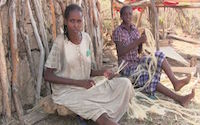The Tapiete Indians are one of the least known and studied groups in the three countries were they are settled: Argentina, Bolivia and Paraguay. Early ethnographers such as Nordenskiöld (1910), Schmidt (1937), Métraux (1946) provide important data on the history and culture of this group. Recent studies conducted among the Tapiete of Bolivia (Gutiérrez 1995, Carbajal 1998, Arce 2003) contribute up to-date ethnographic data.
The Tapiete were traditionally hunters and gatherers who practiced horticulture and inhabited southeastern Bolivia. During the Chaco War between Bolivia and Argentina (1932-1935) the Tapiete were taken as prisoners to Paraguay. Many of them remained in Paraguay after the war while others migrated to Argentina. Similarly, many Bolivian Tapiete migrated to northern Argentina and settled in the outskirts of the city of Tartagal to work in sugar-cane plantations and timber mills. They became a more agriculturally based society, complementing their diet with hunting, but currently they do not practice agriculture, in part due to a lack of access to land. Many of the Tapiete work in temporary jobs in the city of Tartagal and as temporary agricultural workers.
In Argentina, the Tapiete live in a neighborhood known as Mision Los Tapietes (4 blocks in size) in the city of Tartagal (province of Salta), with a population of 750 individuals and which is bordered by Creole neighborhoods. Their children are a minority in the public school located next to their settlement. This, in addition to other factors, such as interethnic marriages has led to a process of culture change and language shift. However, it is interesting to note that in recent years the Tapiete have been involved in a series of exchanges and trips between the Tapiete of Bolivia and those of Paraguay. These contacts have helped revitalize the language in the Argentine community. In the Paraguayan case, the Tapiete are an agricultural based society in close contact with other indigenous groups and Creoles. The Bolivian communities depend on agriculture, hunting, fishing, gathering, and temporal jobs. Language is maintained in both cases.
The implementation of a bilingual education program in Argentina has given indigenous people greater participation in the educational system and an opportunity to value their language and culture in the elementary school. The school located next to Mision Los Tapietes has hired two Tapiete bilingual aids to assist first and second grade Tapiete students.







